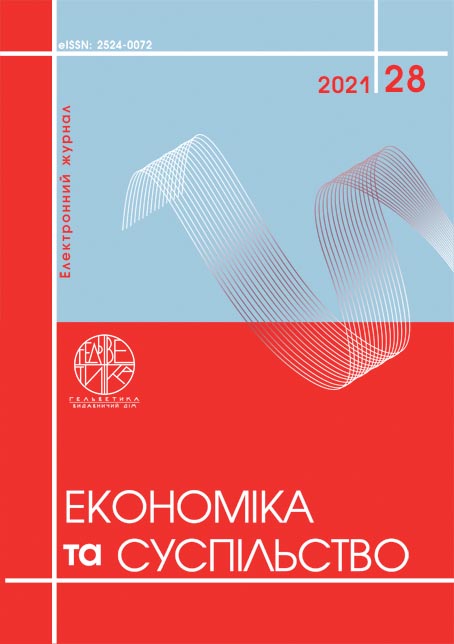LOGISTICS ACTIVITIES IN THE FIELD OF INTERNATIONAL ELECTRONIC COMMERCE
Abstract
The article is devoted to the study of logistics activities in the field of international e-commerce. It was found that since the inception of e-commerce in 1994, it has gradually spread around the world and continues to gain momentum. The development of international e-commerce was significantly influenced by the global pandemic COVID-19, which spurred the rapid development of global retail trade. The analysis of the types of international e-commerce gave grounds to single out the B2C model – the sale of goods and services to individuals as one of the priority segments of the e-logistics market. In the segment of the world market of electronic logistics activities, the following elements of its infrastructure and logistics support can be distinguished: electronic trade lines; internet showcases; online stores (e-shops, e-shop); online auctions; electronic supermarkets; online trading systems. In 2020, the volume of electronic retail sales exceeded 4.28 trillion US dollars worldwide, and in 2021, according to forecasts, it will reach 4.89 trillion US dollars, and in 2024 – 6.39 trillion US dollars . Despite the COVID-19 pandemic and the decline in offline sales worldwide, there has been a two-fold increase in international e-commerce in all regions of the world. The undisputed leaders of growth were: Latin (36.7%) and North America (31.8%). As for the analysis of e-commerce by country, China will continue to lead the global e-commerce market in 2021 ($ 2.8 trillion), followed by a significant lag in the US ($ 843 billion). After China and the United States, the largest e-commerce markets are the United Kingdom ($ 169 billion), Japan ($ 144.08 billion) and South Korea ($ 120.56 billion). Among the types of logistics activities of e-commerce enterprises should be distinguished outsourcing logistics activities (performing logistics operations by the company's own division; fulfilment), logistics outsourcing (fulfilment; postal and logistics operator; logistics provider; dropshipping) and combination of outsourcing, insourcing own division of the enterprise and the transfer of a certain percentage of operations to another enterprise).
References
Батрименко В.В. Запровадження сучасних форм електронної комерції в умовах діджиталізації світової економіки. Стратегія розвитку України. 2019. №2. С. 58–65.
Бергер А.Д., Галета А.С. Світові тенденції розвитку електронної комерції з урахуванням кризових умов пандемії COVID-19. Економіка та суспільство. 2021. № 26. URL: https://economyandsociety.in.ua/index.php/journal/article/view/348
Ільченко Н.Б., Фреюк О.В. Логістика електронної комерції моделі B2C. Innovative scientific researches: European development trends and regional aspect. 2nd ed. Riga, Latvia : “Baltija Publishing”. 2020. P. 86–107.
Омельченко О.В. Розвиток міжнародної логістики в умовах електронізації світової економіки : дис. … канд. ек. наук : 08.00.02. Вінниця, 2015. 232 с.
Тертичний Я.С. Детермінанти розвитку електронної комерції в умовах глобальної дигіталізації : дис. … канд. ек. наук : 08.00.02. Вінниця, 2021. 241 с.
Яценко О.М., Грязіна А.С., Шевчик О.О. Електронна комерція як елемент глобальної торговельної системи. Актуальні проблеми економіки. 2019. №8. С. 4–15.
Keenan M. Global Ecommerce Explained: Stats and Trends to Watch in 2021. URL: https://www.shopify.com/enterprise/global-ecommerce-statistics
Batrymenko V.V. (2019) Zaprovadzhennja suchasnykh form elektronnoji komerciji v umovakh didzhytalizaciji svitovoji ekonomiky [Introduction of modern forms of e-commerce in the conditions of digitalization of the world economy]. Strateghija rozvytku Ukrajiny. № 2. S. 58–65.
Bergher A.D., Ghaleta A.S. (2021) Svitovi tendenciji rozvytku elektronnoji komerciji z urakhuvannjam kryzovykh umov pandemiji COVID-19 [Global trends in the development of e-commerce, taking into account the crisis of the COVID-19 pandemic]. Ekonomika ta suspiljstvo. №26. URL: https://economyandsociety.in.ua/index.php/journal/article/view/348
Iljchenko N.B., Frejuk O.V. (2020) Loghistyka elektronnoji komerciji modeli B2C [B2C model e-commerce logistics]. Innovative scientific researches: European development trends and regional aspect. 2nd ed. Riga, Latvia : “Baltija Publishing”. P. 86–107.
Omeljchenko O.V. (2015) Rozvytok mizhnarodnoji loghistyky v umovakh elektronizaciji svitovoji ekonomiky : dys. … kand. ek. nauk : 08.00.02 [Development of international logistics in the electronic economy of the world economy]. Vinnycja, 232 s.
Tertychnyj Ja.S. (2021) Determinanty rozvytku elektronnoji komerciji v umovakh ghlobaljnoji dyghitalizaciji : dys. … kand. ek. nauk : 08.00.02 [Determinants of e-commerce development in the context of global digitalization]. Vinnycja, 241 s.
Jacenko O.M., Ghrjazina A.S., Shevchyk O.O. (2019) Elektronna komercija jak element ghlobaljnoji torghoveljnoji systemy [E-commerce as an element of the global trading system]. Aktualjni problemy ekonomiky. №8. S. 4–15.
Keenan M. Global Ecommerce Explained: Stats and Trends to Watch in 2021. URL: https://www.shopify.com/enterprise/global-ecommerce-statistics


